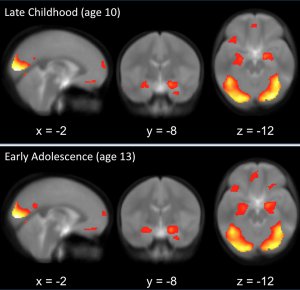 EUGENE, Ore. -- (March 9, 2011) -- Just when children are faced with intensifying peer pressure to misbehave, regions of the brain are actually blossoming in a way that heighten the ability to resist risky behavior, report researchers at three West Coast institutions.
EUGENE, Ore. -- (March 9, 2011) -- Just when children are faced with intensifying peer pressure to misbehave, regions of the brain are actually blossoming in a way that heighten the ability to resist risky behavior, report researchers at three West Coast institutions.
The findings -- detailed in the March 10 issue of the journal Neuron -- may give parents a sigh of relief regarding their kids as they enter adolescence and pay more attention to their friends. However, the research provides scientists with basic insight about the brain's wiring, rather than direct clinical relevance for now.
 In the study, 24 girls and 14 boys from ethnically and socioeconomically diverse backgrounds underwent functional magnetic resonance imaging (fMRI) scans twice, at ages 10 and 13, the latter representing when children have moved into early adolescence. Each time, they were presented with photos of faces making neutral, angry, fearful, happy and sad emotional expressions.
In the study, 24 girls and 14 boys from ethnically and socioeconomically diverse backgrounds underwent functional magnetic resonance imaging (fMRI) scans twice, at ages 10 and 13, the latter representing when children have moved into early adolescence. Each time, they were presented with photos of faces making neutral, angry, fearful, happy and sad emotional expressions.
Non-invasive
fMRI, when focused on the brain, measures blood flow changes using a magnetic
field and radio frequency pulses, producing detailed images that provide
scientists with information about brain activity or help medical staff diagnose
disease.
| Jennifer Pfeifer on Study Highlights |
| Focus of Study |
| Laying a Foundation |
| Amygdala and depression |
Researchers compared the fMRI results from age 10 to age 13, finding that activity increased significantly in the ventral striatum and the ventral medial portion of the prefrontal cortex over this three-year period. In addition to the scans, the researchers considered the children's self-reports on their ability to resist peer influences and engagement in risky or delinquent behavior.
The most enhanced
response occurred in the ventral striatum, a brain region most frequently
associated with reward-related processing. Over time, increases in brain
activity there correlated with increases in children's resistance to peer
influence.
"This is a complex point, because people tend to think of adolescence as the time when teenagers are really susceptible to peer pressure," said Jennifer H. Pfeifer, professor of psychology at the University of Oregon. "That is the case, but in addition to that added susceptibility they are also improving their ability to resist it. It's just that peer pressure is increasing because they spend a lot more time with peers during this time and less time with family. So it is a good thing that resistance to such influences is actually strengthening in their brains."
This study, which researchers believed to be the first to report longitudinal fMRI findings about changes in the way the brain processes emotion during this critical time of brain development, appears to fit into a growing body of evidence that ventral striatum development during early adolescence is critical to emotional regulation carried out by the brain's prefrontal circuitry, the researchers concluded.
"This is basic research that hopefully is laying the foundation for future studies with even more clinical relevance," said Pfeifer, director of the Developmental Social Neuroscience Lab. "We really have a lot to learn about how the brain responds to really basic emotional stimuli across development."
There was a surprise finding that deserves more study, though, Pfeifer said. Responses in the amygdala -- a small almond-shaped mass centrally located deep in the brain -- showed significant increases during this period only to the sad faces.
The amygdala plays a major role in emotional reactivity and indexing the salience of things in the environment. It's possible, Pfeifer said, that this response to sad faces could somehow be tied to the emergence of depression, especially in girls.
"This response in the amygdala raises questions we hope to pursue," she said. "The span from age 9 to 13 is critical in pubertal development. How do individual differences apply here? Identifying this response to 'sadness' in the amygdala opens the door to thinking about how changes in emotional reactivity might be related to the increase in depression that we see as kids enter puberty. Rates of depression are particularly enhanced for teen girls. Is this increased response to sad faces somehow part of that?"
Based on results of the new study, she added, "I think what we know about the ventral striatum may be poised to undergo a transformation over the next several years."
Six co-authors on the study with Pfeifer were: Carrie L. Masten of the Center for Mind and Brain at the University of California, Davis; William E. Moore III and Tasha M. Oswald, both doctoral students in the UO psychology department; John C. Mazziotta of the Ahmanson-Lovelace Brain Mapping Center at the University of California, Los Angeles; and Marco Iacoboni and Mirella Dapretto, both colleagues of Mazziotta and also with the FPR-UCLA Center for Culture, Brain, and Development at UCLA.
The National Center for Research Resources of the National Institutes of Health supported the research through three grants to the collaborating scientists.
About the University of Oregon
The University of Oregon is among the 108 institutions chosen from 4,633 U.S. universities for top-tier designation of "Very High Research Activity" in the 2010 Carnegie Classification of Institutions of Higher Education. The UO also is one of two Pacific Northwest members of the Association of American Universities.